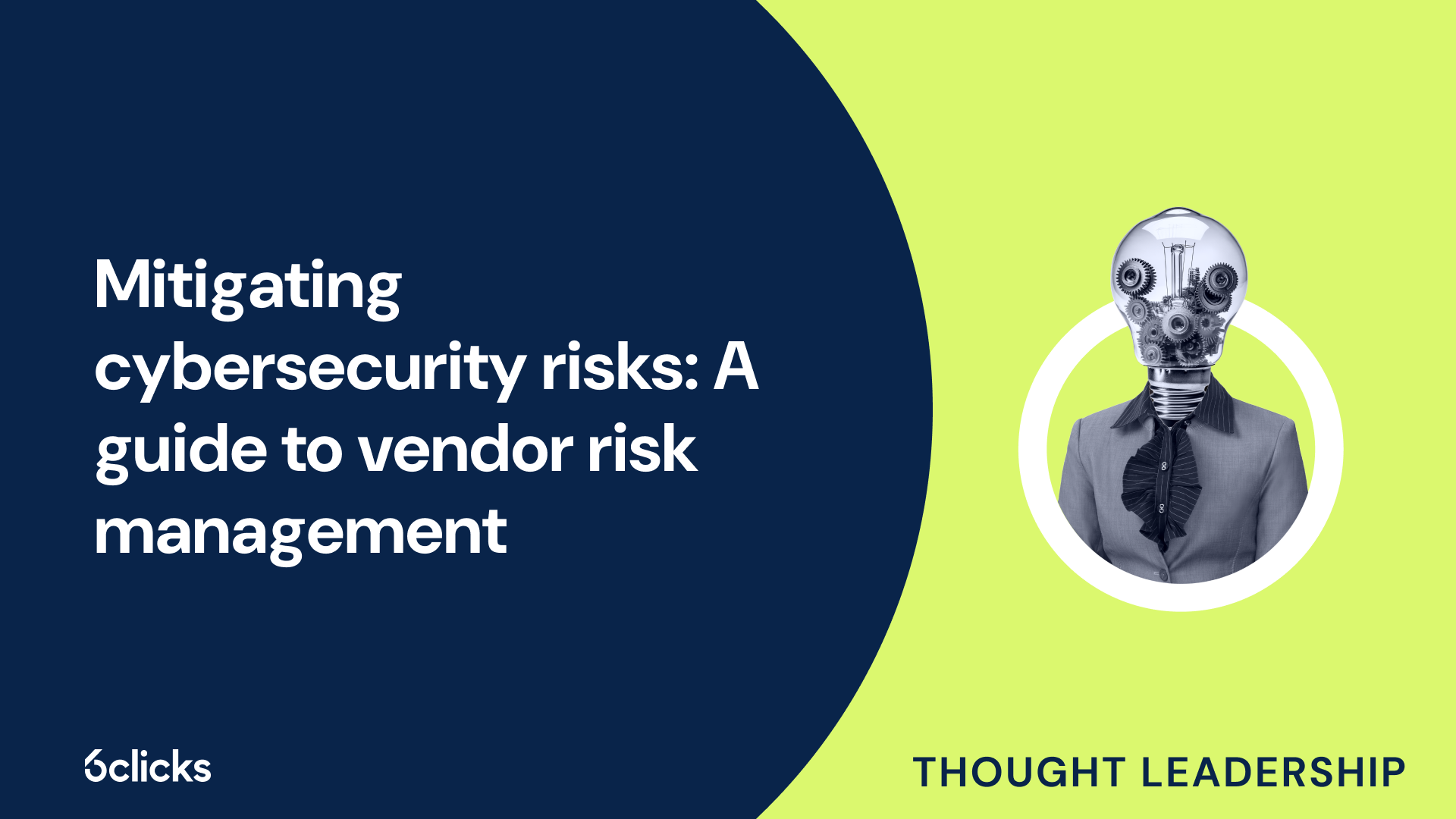The GRC buyer’s guide for 2025: Building resilience with AI-powered, federated solutions
-1.png?width=314&height=391&name=Group%20193%20(1)-1.png)
The GRC buyer’s guide for 2025: Building resilience with AI-powered, federated solutions
What is HITRUST?
HITRUST, also known as the Health Information Trust Alliance, is a widely recognized organization in the healthcare industry. It is built on a framework called the HITRUST CSF (Common Security Framework) that addresses the regulatory requirements and security controls needed for healthcare organizations. The HITRUST CSF provides a comprehensive and risk-based approach to assess and manage the security risk profile of healthcare organizations. It takes into consideration a variety of factors including organization type, regulatory factors, and security control baselines. By using a risk-based approach, HITRUST helps healthcare organizations efficiently comply with regulatory requirements and improve their security posture. The certification process of HITRUST involves a thorough risk assessment, identifying areas of risk exposure, and implementing a security program that aligns with the HITRUST CSF. HITRUST has become the gold standard for healthcare-specific security management standards, making it a trusted choice for organizations looking to achieve and maintain regulatory compliance in the healthcare industry.
What are the controls in the HITRUST framework?
The HITRUST framework simplifies and streamlines cybersecurity for organizations in the healthcare industry. This framework includes a comprehensive set of controls designed to address the unique regulatory requirements and security challenges faced by healthcare organizations.
The HITRUST controls are organized into control categories, objective names, and control references, making it easy for organizations to navigate and implement them. These controls cover a wide range of security areas, including risk assessment, risk management, security policies, network security, security program, and many more.
Furthermore, HITRUST controls are mapped across various standards, such as HIPAA, NIST, ISO, and PCI, to ensure regulatory compliance. This mapping helps organizations understand how the HITRUST controls align with other security frameworks and allows for a more efficient and streamlined compliance process.
HITRUST certification process
The HITRUST certification process is an essential component of the healthcare industry's regulatory compliance requirements. As the healthcare field becomes increasingly digitized and interconnected, organizations must ensure that they meet stringent security control standards to protect sensitive patient data. The HITRUST alliance offers a comprehensive certification framework that helps healthcare organizations assess and manage their risk exposure. This certification process incorporates a risk-based approach, compliance requirements, and regulatory factors to provide organizations with a scalable and efficient approach to achieve their desired security posture. By aligning with various security frameworks and standards, the HITRUST certification process enables organizations to meet the gold standard in security compliance and contribute to the overall improvement of the industry.
How to prepare for HITRUST certification?
Preparing for HITRUST certification involves several important steps to ensure that healthcare organizations meet the necessary security control requirements.
Firstly, organizations must define the scope of their certification by determining which systems, processes, and facilities will be included. This step is crucial because it establishes the boundaries within which the certification will be conducted.
Next, organizations should conduct a comprehensive gap assessment to identify any areas where their current security controls fall short of the HITRUST requirements. This assessment helps organizations understand the level of effort required for remediation and allows them to prioritize their efforts effectively.
Once the gaps have been identified, organizations must diligently work on remediating these issues. This involves implementing appropriate security controls and addressing any deficiencies identified in the gap assessment. Remediation efforts should be well-documented to provide evidence of compliance during the certification process.
Choosing the appropriate HITRUST validation type is also critical. Organizations can choose between self-assessment, validated assessment, or certification. The chosen validation type should align with the organization's risk profile and compliance goals.
Finally, a final HITRUST CSF assessment must be conducted by an accredited assessor firm to evaluate the organization's compliance with the HITRUST framework. This assessment determines if the organization meets the security control requirements and is ready for certification.
Additionally, an interim assessment may be necessary if significant changes occur within the organization's security posture or if certification is required sooner than the standard two-year certification cycle. Interim assessments allow organizations to continuously monitor their compliance status and make necessary adjustments.
By following these steps, healthcare organizations can successfully prepare for HITRUST certification and demonstrate their commitment to regulatory compliance and safeguarding sensitive health information.
What is the role of an assessor firm in the certification process?
An assessor firm plays a crucial role in the HITRUST certification process by conducting the final assessment to evaluate an organization's compliance with the HITRUST framework. These firms are accredited by HITRUST to perform this assessment and ensure that the organization meets the required security control requirements for certification.
The responsibilities of an assessor firm include thoroughly reviewing the organization's security controls, policies, and procedures. They assess the implementation and effectiveness of these controls based on the HITRUST framework. They also review documentation provided by the organization to support their compliance claims.
Furthermore, assessor firms contribute to the certification process by providing their expertise and objectivity. They bring a wealth of knowledge and experience in assessing security controls and compliance in the healthcare industry. Their independent assessment helps ensure that the certification process is rigorous and impartial.
Selecting a qualified and experienced assessor firm is of utmost importance to ensure a smooth and successful certification process. These firms should have extensive experience in performing HITRUST assessments and a deep understanding of the regulatory requirements and security frameworks specific to the healthcare industry. They should also have a demonstrated track record of conducting assessments accurately and efficiently.
By choosing a reputable assessor firm, organizations can benefit from their expertise, guidance, and insights throughout the certification process. This collaboration helps organizations improve their security posture, mitigate risks, and ensure regulatory compliance, ultimately leading to a successful certification outcome.
How does MyCSF tool help in the certification process?
The MyCSF tool is an essential component of the HITRUST certification process, designed to assist organizations in achieving and maintaining compliance. This innovative tool simplifies and streamlines the assessment and certification process, making it more efficient and effective.
One of the key features of the MyCSF tool is its ability to track the progress of an organization's certification journey. It provides a centralized dashboard that allows organizations to monitor their progress in real-time, ensuring that all necessary steps are completed and deadlines are met. This helps organizations stay on track and ensures a smooth and timely certification process.
Additionally, the MyCSF tool enables organizations to securely document evidence and artifacts required for certification. It provides a centralized repository where organizations can upload and store all necessary documentation, making it easily accessible during the assessment and certification process. This eliminates the need for disparate and unorganized documentation, saving time and improving efficiency.
Furthermore, the MyCSF tool offers robust reporting capabilities. It can generate comprehensive reports that showcase an organization's compliance posture and progress towards meeting HITRUST certification requirements. These reports are invaluable in demonstrating an organization's commitment to security and compliance, both internally and to external auditors.
Regulatory requirements and security control baselines
Regulatory requirements and security control baselines are fundamental aspects of the HITRUST Common Security Framework (CSF). As the healthcare industry faces increasingly complex and evolving cyber threats, HITRUST Alliance provides a comprehensive framework that aligns regulatory requirements and industry best practices to enhance security posture. The CSF offers a risk-based approach that takes into account the unique risk profile of healthcare organizations and provides a roadmap for achieving regulatory compliance. The CSF encompasses a multitude of security control baselines that outline specific security requirements to protect sensitive data and systems. These baselines are scalable to accommodate various organization types, including cloud service providers. By leveraging these regulatory requirements and security control baselines, organizations can effectively manage their risk exposure and attain a mature level of security posture that meets the gold standard set by HITRUST Alliance.
What are regulatory requirements for HITRUST compliance?
HITRUST compliance requires organizations to meet a range of regulatory requirements, both legally mandated and related to technical and security standards. These requirements are designed to ensure that healthcare organizations implement effective measures to protect sensitive patient information and maintain a robust security posture.
Legally mandated requirements for HITRUST compliance include regulations such as the Health Insurance Portability and Accountability Act (HIPAA) and the European Union's General Data Protection Regulation (GDPR). These regulations outline specific obligations regarding the handling and protection of personal health information.
In addition to these legal requirements, HITRUST also incorporates a variety of technical and security standards into its framework. These standards cover areas such as network security, security control baselines, and security management standards. By adopting these standards, healthcare organizations can ensure they have a scalable security program that meets industry best practices.
One notable aspect of HITRUST compliance is its integration of the GDPR requirements. The GDPR is a stringent privacy regulation that applies to organizations handling personal data of EU residents. HITRUST helps organizations meet GDPR compliance requirements by aligning its framework with the principles and obligations of the GDPR. This integration provides healthcare organizations with a streamlined and efficient approach to meeting both HITRUST and GDPR compliance.
In terms of information system audit requirements, organizations pursuing HITRUST compliance must undergo regular security assessments to evaluate their security posture. These assessments are conducted by accredited assessor firms and follow the HITRUST framework's certification requirements.
What security control baselines does the HITRUST framework follow?
The HITRUST framework follows security control baselines to ensure comprehensive security for healthcare organizations. These baselines are based on industry best practices and cover various aspects of security.
In the category of Access Control Security (0.1), the primary objective is to control access to information systems and protect the confidentiality, integrity, and availability of data. The relevant security control baselines include access control policies and procedures, user access management, authentication, authorization, and audit logging. These baselines aim to prevent unauthorized access to sensitive information and maintain the appropriate level of access for authorized users.
In the category of Communications and Operations Security (0.9), the objective is to ensure the secure operation and management of information systems. The security control baselines in this category include network security, system hardening, secure configuration management, vulnerability management, incident management, and operational resilience. These baselines help organizations safeguard their systems from potential threats, detect and respond to security incidents, and maintain the overall resilience of their operations.
By following these security control baselines, healthcare organizations can establish a strong security posture, mitigate risks, and meet the compliance requirements set forth by the HITRUST framework.
How can organizations develop an effective risk management strategy with HITRUST?
Organizations can develop an effective risk management strategy with HITRUST by following the HITRUST assessment framework and implementing a comprehensive risk management program. This approach allows healthcare organizations to address regulatory requirements, comply with security standards, and mitigate risks specific to the healthcare industry.
The HITRUST assessment framework provides a certifiable framework that guides organizations through the process of evaluating and managing their risk exposure. By conducting a thorough risk assessment using the framework, organizations can identify potential vulnerabilities and areas of non-compliance. This assessment also helps organizations understand their current security posture and develop remediation plans to address any identified gaps.
Implementing a risk management program based on the HITRUST framework is crucial for healthcare organizations as it allows them to establish a systematic and proactive approach to risk mitigation. This ensures that the organization's risk management efforts are aligned with its overall goals and objectives, improving the efficiency and effectiveness of security controls.
One of the key advantages of the HITRUST framework is its flexibility and adaptability. It takes into account changes in data policies and practices, allowing organizations to stay up-to-date with evolving security requirements. This flexibility enables organizations to adjust their risk management strategy as needed, ensuring that they continue to meet compliance requirements and maintain a robust security posture.
Understanding a risk-based approach to compliance and risk exposure
Understanding a risk-based approach to compliance and risk exposure is essential for healthcare organizations. The HITRUST framework provides a certifiable framework that guides organizations through the process of evaluating and managing their risk exposure. By conducting a thorough risk assessment using the framework, organizations can identify potential vulnerabilities and areas of non-compliance. This assessment also helps organizations understand their current security posture and develop remediation plans to address any identified gaps. Implementing a risk management program based on the HITRUST framework allows healthcare organizations to establish a systematic and proactive approach to risk mitigation. This ensures that their risk management efforts are aligned with overall goals and objectives, improving the efficiency and effectiveness of security controls. The HITRUST framework's flexibility and adaptability are key advantages. It takes into account changes in data policies and practices, allowing organizations to stay up-to-date with evolving security requirements. This flexibility enables organizations to adjust their risk management strategy as needed, ensuring they continue to meet compliance requirements and maintain a robust security posture.
What is a risk-based approach to compliance and risk exposure?
A risk-based approach to compliance and risk exposure in HITRUST is essential for healthcare organizations to effectively manage and mitigate potential vulnerabilities and threats. This approach requires organizations to proactively identify, assess, and prioritize risks, as well as establish and implement appropriate controls to minimize those risks.
By adopting a risk-based approach, organizations can prioritize compliance efforts based on the level of risk and focus resources on areas that pose the greatest threats. This approach allows organizations to allocate budget and resources more efficiently, addressing critical vulnerabilities first.
Furthermore, a risk-based approach enables organizations to continuously monitor and adapt controls to emerging threats and changes in the regulatory landscape. It is crucial for organizations to understand and manage their security vulnerabilities through thorough risk assessments, which help identify weaknesses that need immediate attention.
A risk-based approach ensures that organizations have a comprehensive understanding of their risk exposure and take appropriate measures to manage and minimize it. It involves integrating information security considerations into budget planning and decision-making processes, ensuring that security control implementation is aligned with the organization's overall risk profile.
How does an organization’s type affect its level of risk exposure under HITRUST?
An organization's type plays a significant role in determining its level of risk exposure under HITRUST. The HITRUST assessment process takes into account various risk factors specific to different types of organizations, which ultimately influence the number of applicable requirements.
Firstly, the general risk factors considered are related to the nature of the organization's operations and the type of data it handles. Healthcare organizations, for example, deal with highly sensitive and regulated personal health information, making them more susceptible to data breaches and cyber attacks. This higher risk exposure translates into a greater number of applicable requirements.
Organizational factors such as the size, complexity, and maturity level of the organization also come into play. Large healthcare organizations with multiple locations and diverse systems may face more security challenges and have a higher risk exposure. Consequently, they would have a greater number of applicable requirements.
Geographic factors are another important consideration. Organizations operating in regions with stricter data privacy and security regulations, such as Europe under GDPR, face additional compliance obligations, resulting in an increased number of applicable requirements.
Technical factors, such as the organization's IT infrastructure, network security, and use of cloud service providers, also impact the risk exposure. Organizations relying heavily on technology and interconnected systems may have more vulnerabilities and, therefore, more applicable requirements.
Finally, regulatory factors are significant. Certain industry-specific regulations, such as those governing financial services or pharmaceuticals, impose additional compliance obligations on organizations operating in these sectors, leading to a higher number of applicable requirements.
What maturity levels are used for evaluating an organization’s security posture under hitrust?
HITRUST uses maturity levels to evaluate an organization's security posture. These maturity levels are determined based on the organization's implementation of control requirements outlined in the HITRUST CSF (Common Security Framework).
There are five levels of maturity used by HITRUST:
- Level 1 - Ad Hoc: At this level, an organization has limited security controls in place, and the implementation is unstructured and inconsistent. It indicates a low level of maturity in terms of security posture.
- Level 2 - Defined: This level signifies that an organization has begun to define and document security processes and controls. There is a basic level of structure in place, but it may not be consistently applied across the organization.
- Level 3 - Managed: At this level, an organization has established and implemented a comprehensive set of security controls. These controls are monitored and measured regularly to ensure their effectiveness. The organization demonstrates a proactive approach to managing security risks.
- Level 4 - Measurable: An organization at this level has advanced security controls that are not only implemented but also regularly measured and analyzed for their effectiveness. There is a strong focus on continuous improvement and the use of metrics to assess the security posture.
- Level 5 - Optimized: This is the highest level of maturity, where an organization has fully optimized its security controls and processes. It has a mature and proactive approach to managing security risks and continuously improving its security posture.
By assessing an organization's security controls against these maturity levels, HITRUST provides a comprehensive view of the organization's security posture and helps identify areas for improvement. It also enables organizations to benchmark themselves against industry best practices and demonstrate their commitment to security and compliance.
Cloud service providers and efficient approaches to compliance
Cloud service providers can achieve HITRUST compliance by implementing efficient approaches that align with the HITRUST CSF framework. HITRUST provides a comprehensive set of security controls and requirements specifically tailored for the healthcare industry, allowing cloud providers to offer HITRUST-certified solutions and services to healthcare organizations.
Efficient approaches to HITRUST compliance for cloud service providers include leveraging their existing security control baselines and conducting a thorough risk assessment to identify gaps. By mapping their existing controls to the HITRUST CSF framework, cloud providers can streamline the certification process and ensure compliance with regulatory requirements.
The benefits of using HITRUST-certified solutions and services from cloud vendors like Amazon AWS and Microsoft Azure are numerous. These vendors have undergone rigorous assessments and audits to obtain HITRUST certification, demonstrating their commitment to ensuring the highest level of security and compliance. By relying on HITRUST-certified cloud providers, healthcare organizations can have confidence in the security of their sensitive data and reduce their risk exposure.
Maintaining control measures in the cloud infrastructure requires continuous audits to ensure ongoing compliance. Cloud service providers should regularly assess their security posture, conduct risk assessments, and address any findings through corrective action plans. This proactive approach helps organizations stay ahead of evolving threats and maintain a strong security posture.







